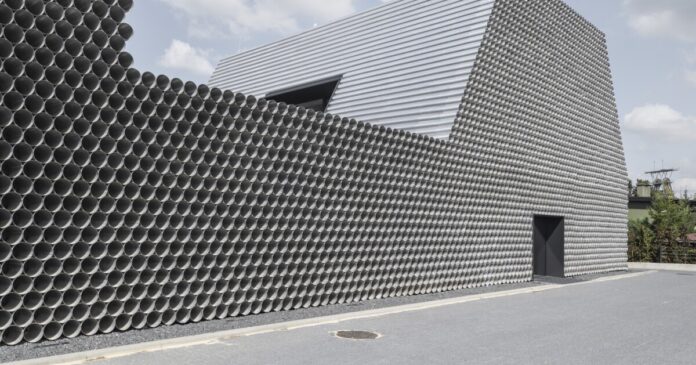Introduction to the Gambit Office
The principle of form following function is a cornerstone in architecture, emphasizing that the design of a building should be driven by its intended purpose. One structure that embodies this principle in a unique and intriguing way is the Gambit Office, designed by KWK Promes for a pipe distribution company. Located in Gliwice, Poland, the building’s façade is almost entirely composed of metal pipes, making it a standout example of memetic architecture.
Design and Construction
The idea to use pipes for the façade arose from the need to work within a relatively tight budget. Initially, the plan was to use pipes sourced from the client, Gambit, but this proved unfeasible due to the pipes’ tendency to oxidize under UV light and their failure to meet fire safety requirements. Instead, KWK Promes opted for raw aluminum sheeting, which was not only more affordable but also had a proven track record from their previous projects, such as the OUTrial House, Unikato, and Konieczny’s Ark. The aluminum sheeting was painstakingly bent into the shape of pipes, covering the building’s concrete structure. The project’s realization took 11 years, from the initial design phase to its completion.
Exterior and Environmental Considerations
The Gambit Office’s exterior is designed to weather over time, with the aluminum expected to develop a pleasant, concrete-like patina that requires minimal maintenance. The pipes at the building’s edges have been capped to prevent them from whistling in the wind, while others have been left open, allowing birds and insects to nest inside. This unique feature not only adds to the building’s quirky charm but also promotes biodiversity. The building’s form is influenced by local planning regulations and the steep roofs of surrounding homes, ensuring it blends into the neighborhood while still maintaining its distinct character.
Interior Design and Functionality
The office interior spans 943 square meters (approximately 10,000 square feet) of usable floor space. It is divided into a two-story section with sloping walls that houses the office area, a lower section that serves as a workshop, and an unheated warehouse for storing pipes. The interior decor highlights the concrete structure and features generous glazing, including multiple skylights, which fills the space with natural light. This design choice creates a bright and airy atmosphere, contrasting with the industrial feel of the exterior.
Conclusion
The Gambit Office, with its unconventional design, is a testament to the creativity and innovation that can be achieved in architecture when form is allowed to follow function in a literal and imaginative way. KWK Promes, known for their unconventional designs such as the Quadrant House and the Open House, has once again pushed the boundaries of what a building can look like while still serving its purpose effectively. As the Gambit Office stands, it not only serves as a functional space for its occupants but also as a landmark that challenges traditional notions of architectural design.

